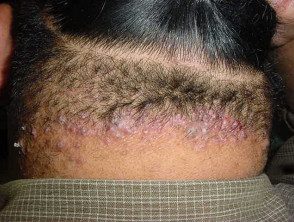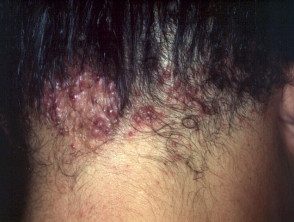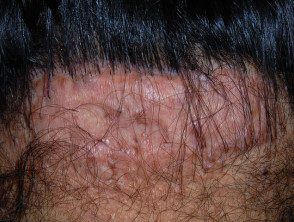What is keloidalis folliculitis?
Keloidalis folliculitis is an unusual form of chronic folliculitisinflammation of hair follicle unit) and scar alopecia (scarring hair loss) that affects the nape of the neck.
Folliculitis keloidalis, or folliculitis keloidalis nuchae, sometimes it's called acne cheloidalis nuchae or acne keloidalis. These names are incorrect because keloidalis folliculitis is not acne and the scars formed are not true keloids. The names are confusing, especially since acne can lead to keloid scars.
Keloidalis folliculitis

Acne keloidalis

Acne keloidalis

Acne keloidalis

Acne keloidalis

Before treatment

After prolonged antibiotics.
See more images of keloidalis folliculitis ...
Who gets folliculitis keloidalis?
Keloidalis folliculitis is more common in dark-skinned people than in white people, and most often affects adult Afro-Caribbean males with black curly hair. It is 20 times more common in men than in women.
How is folliculitis keloidalis?
Initially, small round itchy bumps appear in or near the hair support area of the back of the neck (occipital scalp). These signatures papules can be very itchy and scratching can cause secondary bacterial infection (Staphylococcus aureus. Sometimes there pustules around the hair follicles (folliculitis)
As time passes, the bumps turn into small scars, and then the small scars can become very large to become keloids. Scars are hairless and can form a band along the hairline. Tufted hairs may be present; these are multiple hair stems emerging from a single follicular opening.
What is the cause of keloidalis folliculitis?
Some researchers have concluded that keloidalis folliculitis can start with injury during a nearby haircut or the use of a razor. It is believed to be a mechanical form of folliculitis, in which the ingrown stems irritate the hair follicle wall and cause inflammation. This completely destroys the hair follicle and causes scarring.
Others argue that folliculitis keloidalis is a primary skin disease unrelated to ingrown hairs or bacterial infection.
An association with obesity and metabolism syndrome It has been observed in some patients.
How is keloidalis folliculitis diagnosed?
Diagnosis of keloidalis folliculitis is made clinically by finding follicular papules, pustules, and scars on the occipital scalp. the histology of folliculitis keloidalis nuchae is characteristic, if a biopsy be realized
What is the treatment for keloidalis folliculitis?
Unfortunately, keloidalis folliculitis often persists despite a variety of treatments. The following measures are sometimes useful:
- Make sure clothing and equipment, such as high necklaces and helmets, do not rub on the back of the neck
- Avoid a short haircut or razor.
- Wash the affected area using a antimicrobial cleaner to reduce secondary infection.
- Courses of 2 to 4 weeks of current steroids are useful if the papules are less than 3mm in size
- Steroids injected into lesions (intralesional injections) are best suited for large papules and plates.
- Oral tetracycline as an anti-inflammatory or other antibiotics for secondary infection
- To beAssisted hair removal has been shown to improve keloidalis folliculitis. The best results occur if treatment is started early before significant scarring develops.
- A three-month course of clindamycin and rifampin antibiotics if infection persists
- Surgery to remove large thickened plaques or nodules
-
Laser vaporization or excision and electrosurgery are alternatives to surgery
- Oral isotretinoin
- Radiotherapy
